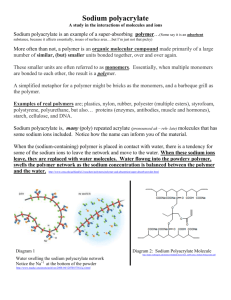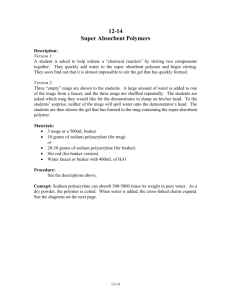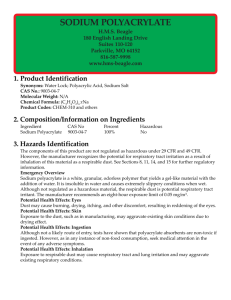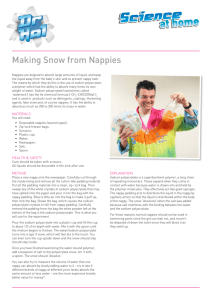Sequestering Agents
advertisement
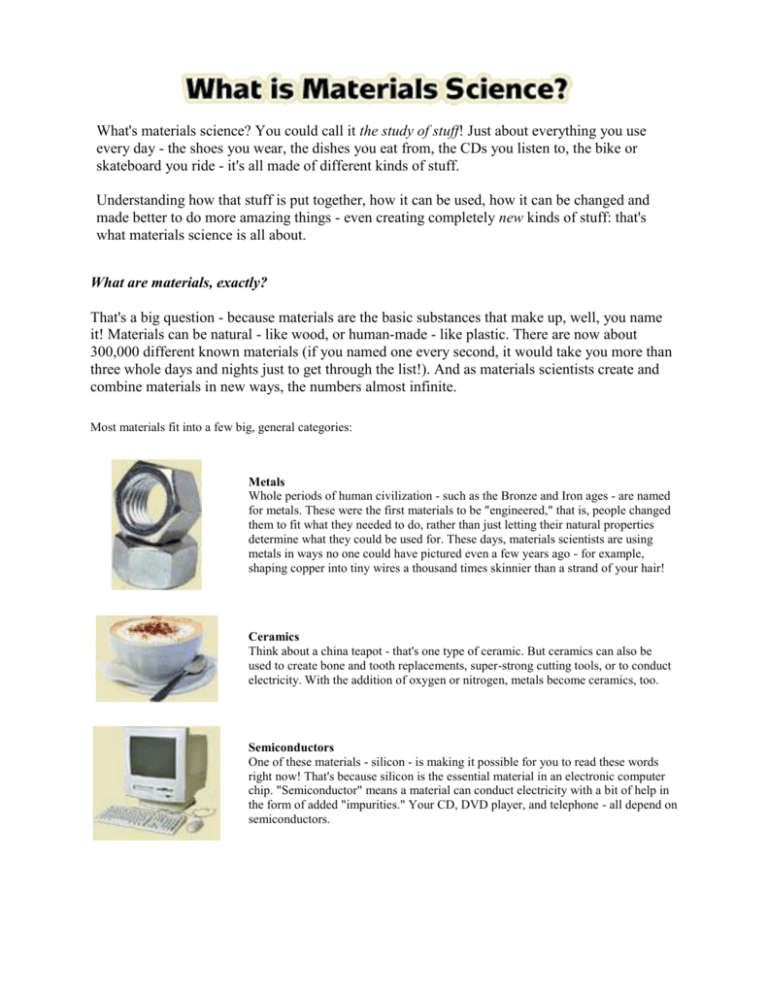
What's materials science? You could call it the study of stuff! Just about everything you use every day - the shoes you wear, the dishes you eat from, the CDs you listen to, the bike or skateboard you ride - it's all made of different kinds of stuff. Understanding how that stuff is put together, how it can be used, how it can be changed and made better to do more amazing things - even creating completely new kinds of stuff: that's what materials science is all about. What are materials, exactly? That's a big question - because materials are the basic substances that make up, well, you name it! Materials can be natural - like wood, or human-made - like plastic. There are now about 300,000 different known materials (if you named one every second, it would take you more than three whole days and nights just to get through the list!). And as materials scientists create and combine materials in new ways, the numbers almost infinite. Most materials fit into a few big, general categories: Metals Whole periods of human civilization - such as the Bronze and Iron ages - are named for metals. These were the first materials to be "engineered," that is, people changed them to fit what they needed to do, rather than just letting their natural properties determine what they could be used for. These days, materials scientists are using metals in ways no one could have pictured even a few years ago - for example, shaping copper into tiny wires a thousand times skinnier than a strand of your hair! Ceramics Think about a china teapot - that's one type of ceramic. But ceramics can also be used to create bone and tooth replacements, super-strong cutting tools, or to conduct electricity. With the addition of oxygen or nitrogen, metals become ceramics, too. Semiconductors One of these materials - silicon - is making it possible for you to read these words right now! That's because silicon is the essential material in an electronic computer chip. "Semiconductor" means a material can conduct electricity with a bit of help in the form of added "impurities." Your CD, DVD player, and telephone - all depend on semiconductors. Polymers Polymers are just very big molecules made of smaller molecules linked together into long, repeating chains. You may not know it, but you're in touch with polymers every day more than any other kind of material. Rubber bands are made of polymers, so are paints and every kind of plastic. And by the way, most of the food you eat is made of natural polymers! Others are little tougher to define... Composites Composites are combinations of materials, which can be as simple as concrete reinforced with steel bars or as leading edge as an ultra light, carbon-fiber bicycle. The places where different materials meet - the "interfaces" - often produce new properties that are radically different, and better, than those in any single material. Biomaterials Every part of your body is a material! Bone, muscles, fingernails, hair, and skin are all examples of different types of materials found in your body with remarkable properties that help you survive - from keeping you upright, and protecting you from heat or cold, to cutting and grinding your food. Some scientists try to mimic nature's designs to create materials for other uses, such as using the foam structure of bone as an inspiration for designing materials that are lightweight and strong. And some are just plain weird... Exotic and Strange Materials Materials scientists are discovering and creating entirely new types of materials such as Bucky balls and nanotubes, which are very tiny spheres or cylinders made of carbon atoms. Then there are aerogels, which are extremely lightweight porous materials made almost entirely of air! Nanotechnology is taking materials science into a new dimension, as scientists create new materials atom-by-atom and moleculeby-molecule - leading to properties and performance never before imagined. Who are materials scientists and what do they do? You've probably heard of a chemist, a biologist or a physicist, but have you ever heard of a materials scientist? Probably not. One reason is that materials science covers a huge range of activity and touches on many different fields - including chemistry, biology and physics! Sometimes materials scientists are called ceramic or polymer engineers or metallurgists, and you can find them working in industries, labs, and universities all over the world. But diverse as they are, materials scientists look at materials from a unified point of view: they look for connections between the underlying structure of a material, its properties, and how processing changes it, and what the material can do - its performance. In the past, people used and changed materials by trial and error. And they worked on a big, visible scale - for example, heating then rapidly cooling chunks of iron to make it harder. Modern materials scientists manipulate and change materials based on fundamental understandings of how the materials are put together, often on the invisibly tiny scale of atoms. How small is that? To make a speck as big as the period at the end of this sentence, you'd need trillions of atoms. How Does the Fortune Teller Miracle Fish Work? If you hold the red plastic Fortune Teller Miracle Fish in your hand it will bend and wiggle as if by magic. The movements of the fish are a result of the chemical used to make the fish. The Fortune Teller Miracle Fish is a novelty item or kid's toy. It is a small red cellophane fish that will move when you place it on your hand. Can you use the movements of the toy to predict your future? Well… you can, but expect about the same level of success, as you would get from a fortune cookie. It doesn’t matter, though, because the toy is great fun! The Fortune Teller Fish is made of the same chemical used in disposable diapers, sodium polyacrylate. Sodium polyacrylate will grab onto water molecules that it touches, changing the shape of the molecule. As the molecules change shape, so does the shape of the fish. If you submerge the fish in water, it won't be able to bend when you place it on your hand. If you let the fortune teller fish dry out, it will be good as new. Sodium Polyacrylate - http://www.youtube.com/watch?v=Vais8pL0w8U - go to this URL or click on this active link to see a demonstration of this materials major property. Sodium polyacrylate, also known as waterlock, is a sodium salt of polyacrylic acid with the chemical formula [-CH2-CH(COONa)-]n and broad application in consumer products. It has the ability to absorb as much as 200 to 300 times its mass in water. Sodium polyacrylate and other derivatives of polyacrylic acid have a wide variety of commercial and industrial uses that include: Super absorbent polymers. These cross-linked acrylic polymers are referred to as "Super Absorbents" and "Water Crystals", and are used in baby diapers. Copolymer versions are used in agriculture and other specialty absorbent applications. The origins of super absorbent polymer chemistry trace back to the early 1960s when the U.S. Department of Agriculture developed the first super absorbent polymer materials. This chemical is featured in the Maximum Absorbency Garment used by NASA A Maximum Absorbency Garment (MAG) is a piece of clothing NASA astronauts wear during liftoff, landing, and extra-vehicular activity (EVA) to absorb urine and feces. It is worn by both male and female astronauts. Astronauts can urinate into the MAG, and usually wait to defecate when they return to the spacecraft. However, the MAG is rarely used, since the astronauts use the facilities of the shuttle or station before EVA and also time the consumption of the in-suit water. Nonetheless, the garment provides peace of mind for the astronauts. The adult-sized diaper with extra absorption material is used because astronauts cannot remove their space suits during long operations, such as spacewalks that usually last for several hours. Generally, three MAGs were given during space shuttle missions, one for launch, reentry, and an extra for spacewalking or for a second reentry attempt. Astronauts drink about 2 L (2.1 US qt) of salty water before reentry since less fluids are retained in zero gravity. Without the extra fluids, the astronauts might faint in Earth's gravity, further highlighting the potential necessity of the MAGs. It is worn underneath the Liquid Cooling and Ventilation Garment (LCVG). Sequestering Agents Sodium polyacrylate is commonly used as a sequestering agent, or chelating agent, in many detergents. It has the ability to bind hard-water elements, such as magnesium, calcium, iron and zinc, to make the detergents work more effectively. Chelating agents neutralize the presence of heavy metals that may be found in water, dirt and other substances that can be found in your laundry, making the detergent more effective in cleaning and neutralizing odors in your clothes Thickening Agents Sodium polyacrylate is primarily used as a thickening agent because of its unique ability to absorb and hold onto water molecules, making it ideal for use in diapers and hair gels. It is also used in industrial processes to dissolve soaps by absorbing water molecules. Thickening agents, like sodium polyacrylate, increase the viscosity of water-based compounds, which increases their stability. In diapers, sodium polyacrylate will absorb the water molecules found in urine, increasing the amount of liquid the diaper can hold while at the same time reducing the risk of diaper rash by promoting a dry environment. Coatings Sodium polyacrylate has been included in the coatings of sensitive electrical wiring to keep moisture away from the wires. Water and moisture conduct electricity, and can interfere with the transmission of electrical signals along wires that transmit elecrical signals, causing damage to the wire and creating a potential fire hazard. When sodium polyacrylate is infused in the protective rubber coating around a wire, it protects the wire from exposure to moisture, ensuring the safe transmission of electrical signals.

